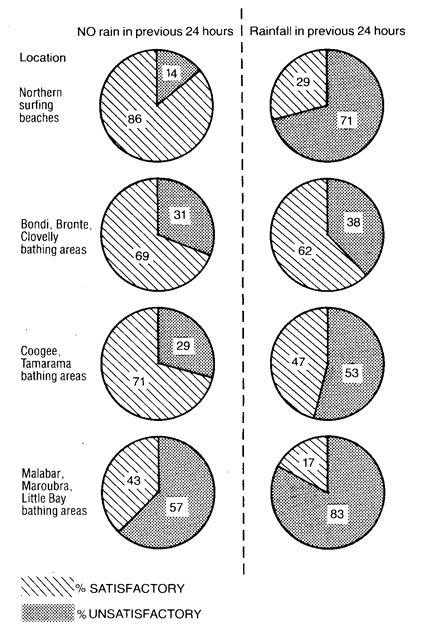
by Sharon Beder
first published by Allen & Unwin, Sydney, 1989
Introduction
Sewers seaward
Toothless watchdog
Toxic fish
Sewer-side surfing
Public relations battle
Events of 1989
Beyond Sydney
Conclusion
Bibliography
There has never been any shortage of anecdotal evidence that swimming in sewage polluted water is unhealthy. However, the experts disagree on just how unhealthy it is and on how polluted the water needs to be before it poses a health risk. The authorities have always differed from the bathers and surfers in their attitude to this. But there has been little investigation of the part of those same authorities.
Part of the difficulty is that the symptoms of disease might not occur until some time after exposure. Furthermore, many diseases that could be transmitted in this way can also be transmitted in other ways. Nevertheless the SPCC still held the view at the end of 1979 that coastal waters could be presumed safe for swimming if aesthetic criteria were met; in other words, where there was no visible faecal matter or other materials ‘clearly of sewage origin’, no ‘noticeable’ turbidity or discolouration of water attributable to sewage and no ‘perceptible smell’.
This view was based on a 1959 study undertaken in the UK, which is still referred to in Britain, Australia and New Zealand as the classic paper on the subject despite the continuing debate amongst experts, new research and developments in the field of virology and the various papers reaching contrary conclusions that have been published since that date. The 1959 study was confined to the study of a few diseases such as typhoid fever and poliomyelitis, which have been traditionally associated with sewage.
The 1959 study was based on a five-year investigation of 43 UK beaches. It concluded that there was only a ‘negligible risk to health’ of bathing in sewage-polluted sea water even when beaches were ‘aesthetically very unsatisfactory’ and that a serious risk would only exist if the water was so fouled as to be revolting to the senses. The author of the study, B. Moore, believed that bathing was ‘an unnatural activity in man’ and he ascribed the prevalence of upper respiratory infections in bathers to the mechanical effect of bacteria being forced up the nose and into the middle ear when diving or to close personal contact with fellow bathers. He dismissed without further investigation the idea that such infections might be caused by pathogens from contaminated waters. For this reason his working group did not concern itself with upper respiratory infections. Other relatively minor diseases such as viral gastro-enteritis, were ignored.
In contrast, epidemiological studies in the US since the early 1950s have considered minor diseases, demonstrating connections between these and bathing in waters that are mildly contaminated with sewage. In 1980 a US Environmental Protection Agency spokesman claimed:
. . . surveys of 30,000 bathers and non-bathers contacted on beaches in New York and Boston revealed statistically significant increases in cases of vomiting, diarrhoea, nausea, fever and stomach aches among swimmers who had bathed in polluted waters . . . The results show a strong link between bacteria counts in the water at the time of bathing and subsequent health of the swimmers. (New Scientist, 16/7/81)
A 1987 US report from the Office of Technology Assessment found that sewage-polluted bathing waters were responsible for relatively high rates of gastro-intestinal disease and that the outbreaks of water-borne diseases, including hepatitis, had been steadily increasing in the past decades.
The British have at least recognised that in warmer countries people might swim for longer periods and the risks would be higher. So why have the Australian authorities chosen to use British rather than American studies? Our bathing habits are more closely aligned to those in the US. The lack of Australian data is used by the authorities to argue that ‘there is no evidence’ that sewage pollution poses a health risk to swimmers.
In 1987 a leaked confidential Department of Health report was passed on to surfing reporter, Kirk Willcox. It included the following:
Salmonella serotypes continue to be recovered from water samples from beaches in the Waverley and Randwick municipalities. In the last 3 years Salmonella Paratyphi B has been isolated on 2 previous occasions, However on 6 out of 9 sampling occasions between 20 October and 15 December, 1986, S. Paratyphi B was positively identified in water samples from Maroubra, Coogee, Malabar and McMahon’s Pool. (Public Health Report, Jan-Feb 1987)
According to Professor Clem Boughton, head of the Infectious Diseases Department at Prince Henry Hospital, salmonella serotypes could cause diseases similar to gastro-enteritis and salmonella paratyphi B could cause paratyphoid fever. He said that other infectious diseases such as polio and hepatitis A and B, typhoid, rotavirus and other enteroviruses were likely to be in beach waters, given the presence of salmonella (Eastern Herald, 2/4/87). Dr Nancy Millis of the School of Microbiology at Melbourne University warned as early as the 1970s that the presence of even one salmonella in a sample indicated a definite health risk. The numbers of salmonella organisms necessary to cause disease differed according to the strain of salmonella and susceptibility of individual people.
The leaked report showed results of a much longer study undertaken by the New South Wales Department of Hea1th. A paper given at an International Conference on Water Quality and Management or Recreation and Tourism in 1988 summarised data collected by the Department between October 1983 and April 1987. Salmonella was detected in 183 out of 1058 (17 per cent) samples tested at eastern suburbs swimming spots and beaches (including Malabar, which is closed for swimming) over the three-and-a-half years. Moreover, the Health Department’s monitoring of bacteria levels at beaches found that the eastern suburbs beaches were unsatisfactory for swimming for between 29 and 83 per cent of the time (see Figure 4.1).
Figure 4.1 Health Department testing of bathing areas, 1983-87

Information from: Bernard, 1988
These pie charts show the percentage of time that bathing waters were determined to be satisfactory for swimming according to the NSW Health Department. The darker shade shows the unsatisfactory percentage and the light shade the percentage of time that the bathing waters were satisfactory for swimming. The left hand charts show the results for dry weather and the right hand charts show the results for bathing waters after rainfall.

Source: Stay In Touch, Sydney Morning Herald, 19/4/88.